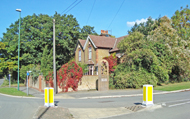Mental
In 1955 the Polish Neurosis Unit at Mabledon Park in Tunbridge Wells (see below) was relocated to the surviving buildings of the Lower Southern Hospital in Gore Road. These consisted of three lines of huts down the hillside, containing the wards, offices and staff accommodation.
The Unit was under the direction of Dr George Bram, a Polish-Jewish physician, and was staffed by Polish doctors and nurses. It served the whole of Britain's Polish population, as well as the local non-Polish population. The 200 patients were mostly ex-soldiers, whose only possessions were their uniforms. Traumatised and shell-shocked by the war and unable, for various reasons, to return to Poland, they were given psychiatric help to enable them to rebuild their lives in a new country. Both men and women were admitted, with the majority being males aged between 40 and 50 years. About 10% were under 21 years old. Patients came from all walks of life - professors, doctors and manual workers. Half the woman had been housewives.
The patients immediately began to improve their living accommodation by planting flower and vegetable gardens. They built themselves a Centre from the material left from the demolition of the Lower Hospital. This Centre contained a library, reading rooms and a canteen, as well as a television.
In 1959 the Unit was reclassified as a psychiatric unit and renamed the Mabledon Hospital. It had 137 beds.
The English patients consisted of three groups. A small shifting population of Hampstead artists, who had been referred from the Tavistock Clinic, were under the care of Dr Bram. A second group were NHS patients from South London, consisting mainly of women with depression. The third group were under the care of Dr Harry Rose, who were encouraged to talk about their feelings in weekly group sessions.
By the early 1960s the third line of huts was deserted apart from a changing population of homeless Polish aristocrats, ex-patients and visiting lovers. The food at the Hospital remained basically Polish, with a deli-van visiting to provide Polish treats. The Hospital had Polish signage. In addition to English language films, Polish films were also screened. Weekly dances were held, a Polish newspaper was published and occasionally Polish entertainers visited.
Following a major reorganisation of the NHS in 1971 the Hospital came under the administration of the Dartfod and Darenth Hospital Management Commitee, part of the South East Thames Regional Health Authority.
In 1974, following another major reorganisation of the NHS, the Hospital came under the administration of the Dartford and Gravesham District Health Authority.
Most patients recovered, but some became institutionalised. Some moved to refugee camps, such as the one at Lilford in Northamptonshire (some camps remained open until the last inmates died of old age).
In 1985 the Hospital closed and the remaining patients were transferred to the newly renovated Sikorsky Ward in Stone House Hospital in Dartford.
Present status (October 2008)
The Hospital was demolished. The site became part of the English Partnerships' 'Hospital sites programme'. It was projected as part of the Thames Gateway regeneration proposed by the Secretary of State for Health, but Dartford Borough Council successfully resisted the proposed housing development of up to 288 units and planning permission was refused.
In 2005 the Deputy Prime Minister, John Prescott, dismissed a planning appeal by the Secretary of State for Health and the Department of Health and Social Care.
The former Hospital site is now part of the Darenth Country Park.

The entrance to Darenth Country Park off Gore Road.

The entry drive from Gore Road. No trace remains of the Hospital.
Mabledon Park, a 'small' country house in Tunbridge Wells, had been built around 1805. It was inherited by the Church Pastoral Aid Society (CPAS), who used it as a 'home of rest for clergy and laymen and laywomen' engaged in the work of Church Societies.
In 1945 it was used to house Italian ex-Prisoners-of-War, then became a Rehabilitation Centre for British Prisoners-of-War returning from camps in the Far East.
It was then utilised as a psychiatric hospital for Polish soldiers and refugees. The house and grounds were considerably restored at this time and new prefabricated huts were erected as an Occupational Therapy Unit.
In July 1948 Mabledon Park Hospital joined the NHS along with Stone House Hospital and Darenth Park Hospital under the control of the Darenth and Stone Hospital Management Committee, part of the South East Metropolitan Regional Health Authority.
The Ministry of Health threatened to make a compulsory purchase of the building if the Trustees would not sell or grant a long lease. The Trustees offered ten years, with the possibility of reconsideration after five years. The Ministry declared they would leave at the end of 1954, but because of difficulties in finding alterative accommodation for the hospital it was not until the middle of 1955 that the Polish unit left.
In 1956 the CPAS once again opened Mabledon Park as a rest home. By 1989 it was no longer required by the Society and was put up for sale. It remained vacant for three years until it was purchased as a private home in 1992.
Bram G 1983 Breakdown in elderly Polish refugees. In: Baker R (ed) The Psychosocial Problems of Refugees. London, The British Refugee Council.
Mills M 2016 A Patient Experience. The Polish Mental Hospital in Dartford. HopSIG NEWS and NOTES 2, 5-6.
Stachura PD (ed) 2004 The Poles in Britain, 1940-2000: From Betrayal to Assimilation. London, Frank Cass Publishers, 88-90.
Winslow M 2001 War, Resettlement, Rooting, and Aging: An Oral History Study of Polish emigres in Britain. Thesis, University of Sheffield.
https://dartfordhospitalhistories.org.uk (1)
https://dartfordhospitalhistories.org.uk (2)
https://dartfordhospitalhistories.org.uk (3)
https://eehe.org.uk
https://hansard.parliament.uk
www.mabledon.co.uk
Return to home page